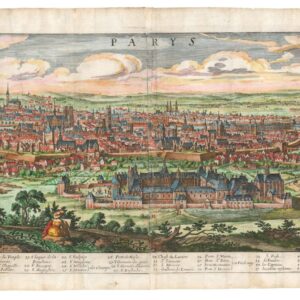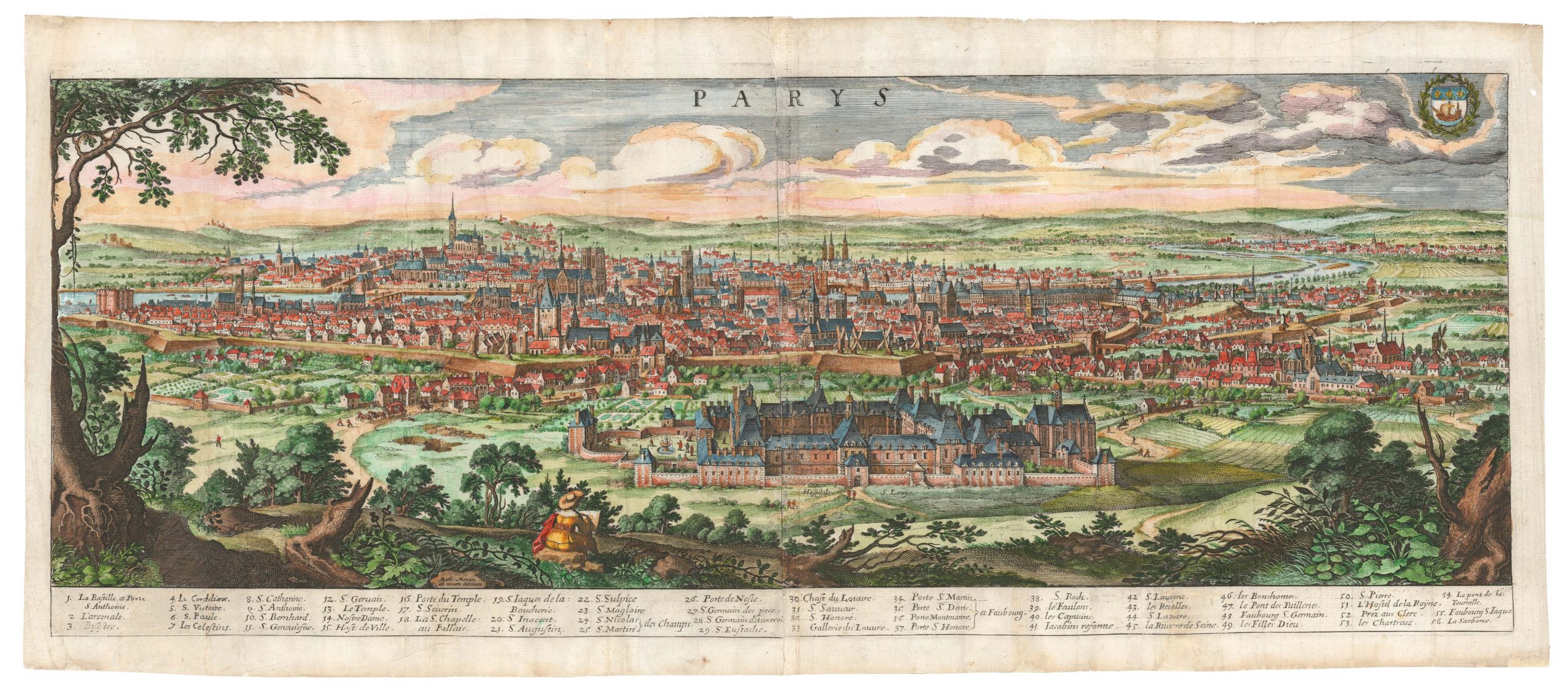Visscher’s seminal map of the Kingdom of Denmark, borne out of the ashes of the Thirty-Year-War.
Regni Daniae, Novissima et Accuratissima Tabula
$450
1 in stock
Description
This is Nicholas Visscher’s folio map of the Kingdom of Denmark. It was executed as a masterful copperplate engraving and was included in his Atlas Contractus Orbis Terrarum Praecipuas ac Novissimas Complectens Tabulasm, a large compendium of maps published by the Visscher firm from their Amsterdam workshop around 1677. In the upper right corner we find the elegant title cartouche, which identifies the map’s subject and author. The cartouche is borne on a heraldic shield with three lions flanked by two men with clubs. This was the crest of the Danish King Christian V (1646-1699).
The engraving is generally of very high quality and clearly the work of a master cartographer balancing the conveyance of information and beauty most elegantly. The map is filled with cities, towns, and villages interspersed with vignettes of groves and some overstated hillocks. In general, it is quite clear that already at this stage, Denmark is both relatively densely inhabited and cultivated, an unsurprising feature in a country that has been completely deforested since the Bronze Age.
Resting on more than 10 kilometers of unmetamorphosed sediments (i.e. chunky clay and no bedrock) and being far from mountains, Denmark has no great rivers, but the few streams large enough to merit the label have all been correctly plotted (e.g. Gudenåen or Susåen). On either side of the landmass, we find the maritime spheres of the North Sea and Baltic Sea, respectively, a divide that Denmark has straddled through most of its history.
Context is Everything
When this map was compiled in the 1670s, Denmark had become a shadow of its former self. Betting consistently on the wrong horses, Christian IV had lost one of Europe’s most extensive empires during the Thirty-Year-War, which had engulfed most of Europe in religious feuding between 1618 and 1648. The Kingdom of Denmark had consequently shrunk to a size that could neatly fit the type of double-page folios that Dutch atlases sported at the time.
On this particular map, we see Denmark more or less as it exists today, consisting of the continental peninsula of Jutland and surrounded by 500 bigger and smaller islands. On the largest of these, Zeelandt (Sjælland), we find the capital of Copenhagen in the upper right corner of the island. In the lower-left corner of the map, we see how, even after the contraction of the Empire, the north German provinces of Schleswig and Holstein remain in Danish hands. They would continue to do so until a crushing defeat by Prussia in 1864.
However, with this map being a product of the late 17th century, it is far more interesting to note how the three Swedish provinces of Skåne, Halland, and Blekinge have been rendered on this map. These three provinces receive the same attention to detail and are held in the same color scheme as the rest of Denmark, which contrasts sharply with how the rest of Sweden is portrayed. The reason for this can be found in the Treaty of Roskilde from 1658, in which the Danish king agreed to surrender these provinces to a much more powerful Sweden.
It would be tempting to attribute a motive to omitting Sweden’s subjugation on Visscher’s map. Had this proprietary shift gone unnoticed in the workshops of Amsterdam? Or did people simply not think it would last? The explanation is that Visscher, like his counterparts, drew heavily on older maps and charts when compiling new ones. Skåne, Halland, and Blekinge had been part of Denmark since Harald Bluetooth conquered the region in the 10th century, and there did not exist many maps at the time that did not portray these provinces as a core part of Denmark.
The anachronistic rendition is because the dataset behind this particular map comes from a national survey conducted by the royal geographer, Johannes Mejer, after the end of the Thirty-Year War. The results were made available to the Dutch cartographers, and Joan Blaeu was the first to compile a map from this unique dataset. Both Blaeu’s map and the original survey results were likely among the primary sources when Visscher compiled this map.
Cartographer(s):
Nicolaes Visscher I (1618 – 1679) was a prominent Dutch engraver, cartographer, and publisher who was born and worked in the Dutch capital of Amsterdam. He was the son of Claes Janszoon Visscher (1587 – 1652), who established the family’s publishing firm and cemented the family as some of the most prominent Dutch mapmakers for nearly a century. The firm initially lay near the offices of two other great Dutch mapmakers in Amsterdam, namely Pieter van den Keer and Jacodus Hondius, and most historians believe that Visscher senior probably had been apprenticed with Hondius.
Upon his father’s death, the firm was passed on to Nicholas Visscher, who in 1677 received Dutch royal privilege to issue maps. Nicholas Visscher’s son, Nicolaes Visscher II (1649–1702), trained with his father and took over the family business upon his death in 1679. When Visscher II died in 1702, his widow continued the firm until the plates were sold to Peter Schenk in the 1720s. The Visscher family stands as one of the most important in the history of Dutch cartography. In addition to the respective members’ names, many of their maps also bear the imprint Piscator, the Latinised version of the family name (Visscher means fisherman in Dutch). Sometimes, the maps even feature the image of an elderly fisherman.
Condition Description
Various repairs and infill, and other blemishes. Nice old color.
References






